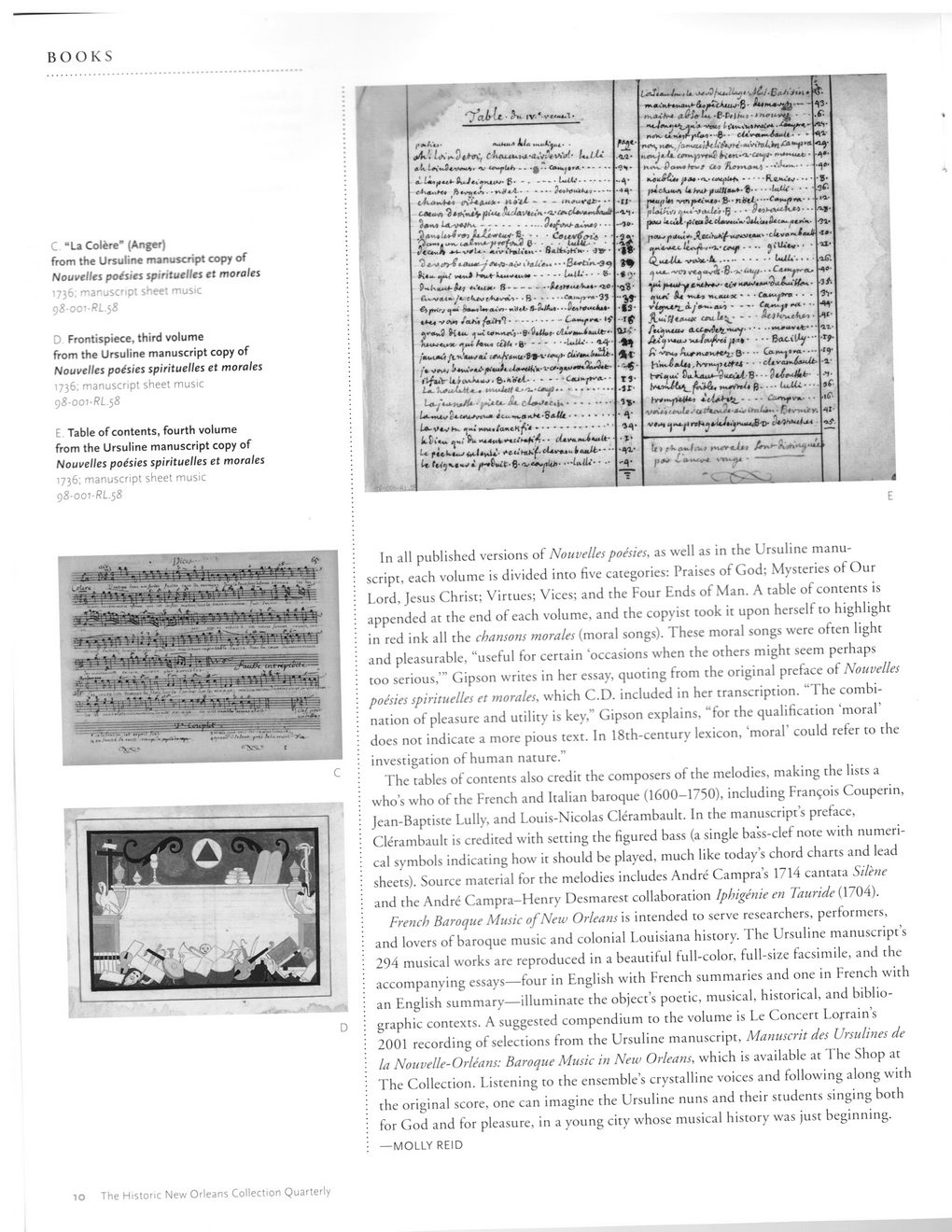This text was obtained via automated optical character recognition.
It has not been edited and may therefore contain several errors.
BOOKS C “La Colire’ (Anger) from the Ursuline manuscript copy of Nouvelles poesies spirituelles et morales 1736: manuscript sheet music 9S-001-RL.5S D Frontispiece, third volume from the Ursuline manuscript copy of Nouvelles poesies spirituelles et morales 1736; manuscript sheet music g8-ocn-RL.58 E Table of contents, fourth volume from the Ursuline manuscript copy of Nouvelles poesies spirituelles et morales 1736; manuscript sheet music 9S-001-RL58 D IV- ItK * *^tuI *rf f5* - - - • l+UA.".... A - • > • • - - * - — tA-OK+41 ni'lt - - - • • - -......................• * PtCfelA U.» *(Vl• -J^ 9\4u. (p* H»J ttuv«im - - • - B > •> - - > &*-vii-t»wV eU-+jc.*v^*L->- • B...........c*»4^»v«‘33 €if»rirj «<fe4-- 6<2aiAfc*. ■ • $d/»y*L*<Ju4- tA<4 ■v c*i*i /aAi ................. ^«4< 9.6*4^. W/M1 e&A >B......................■ 4.4-- fI." '<u*ya*" »t/l*V • * - • • C«JK|t»*A- • M. « • ........ Lflty • ^viU- j2i C-/^<C4|4 • •......... £m-»h*v ........ Ia-V*v Kv «f*** ttMi/aneK^ k&i’c. t* fit, Lius intuit. * • te fn‘(|\«iW» /f‘*£Wt'l9-<V«Ayl(«J>- •••luM4* ■SI *% «o* o$- ■a* *3 ok- * %< T5- •ir- 1v * *<*• J* V.* A’ r**Cpit-*+a^^j£ckuw-fi • ^3- lu •6-P«|>ut • I • ,6s. •* ftWt'MMy*' I*—yi ^- AS *n- %• *wir- v — "i 11 |TM<"Tf ■ * • K4*.j*A. t*n*.pyt*£ ■ •<*“ Hiav Cu - ■«<!«<».• • • •< ;*«« . . • • • R.®.H*W - • ■ fHtWl >ru> jlldUn*+-^...............ImMi’ ■ • • p*«|» Im "VTD p-ti+H*- 8- • -------------. pl+L(iirt /-/M-tVcuitV-IJ • • • $ *>*■<*** ■ ■ pAU *t*^fJl'caS<.C^V*fc.V3*/ii*«iUc.l*..#fcW*. peu^ouhiA'f'tuft&tMM'- cUv+ c^*f ■ - •• • -VTAk^t -A................UdU . • . ■ y** • <jica’ A4 *v4o n^«tfx % * • CAM^y*rn • • • c*uU^' - • • <4*;vu<A*>• a.t£ey^eJfe.'*<*Y......... -uuJoi^ci jja% • • - • JJaciUy •• A' ‘■‘'Vk* /u/n^h^. 3- • •■ Ca-»*^«ra----------------- lify ■ ■ ■ clxvaiiJ&MAt. Qu.[*aaA-T)u£t4A.-1$- ■ ■ ()d>ru4U±-v*+f>Ui f3 - • • • Uotl*. • • hr*r+^fltil4l 4• • • • • , »tuw • c>>^ In all published versions of Nouvelles poesies, as well as in the Ursuline manuscript, each volume is divided into five categories: Praises of God; Mysteries of Our Lord, Jesus Christ; Virtues; Vices; and the Four Ends of Man. A table of contents is appended at the end of each volume, and the copyist took it upon herself to highlight in red ink all the chansons morales (moral songs). These moral songs were often light and pleasurable, “useful for certain ‘occasions when the others might seem perhaps too serious,’” Gipson writes in her essay, quoting from the original preface of Nouvelles poesies spirituelles et morales, which C.D. included in her transcription. “The combination of pleasure and utility is key,” Gipson explains, “for the qualification ‘moral’ does not indicate a more pious text. In 18th-century lexicon, ‘moral’ could refer to the investigation of human nature.” The tables of contents also credit the composers of the melodies, making the lists a who’s who of the French and Italian baroque (1600-1750), including Francois Couperin, Jean-Baptiste Lully, and Louis-Nicolas Clerambault. In the manuscript’s preface, Clerambault is credited with setting the figured bass (a single bass-clef note with numerical symbols indicating how it should be played, much like today’s chord charts and lead sheets). Source material for the melodies includes Andre Campra’s 1714 cantata Silene and the Andre Campra-Henry Desmarest collaboration Iphigenie en Tauride (1704). French Baroque Music of New Orleans is intended to serve researchers, performers, and lovers of baroque music and colonial Louisiana history. The Ursuline manuscript’s 294 musical works are reproduced in a beautiful full-color, full-size facsimile, and the accompanying essays—four in English with French summaries and one in French with an English summary—illuminate the object’s poetic, musical, historical, and bibliographic contexts. A suggested compendium to the volume is Le Concert Loxrain’s 2001 recording of selections from the Ursuline manuscript, Manuscrit des Ursulines de la Nouvelle-Orleans: Baroque Music in New Orleans, which is available at The Shop at The Collection. Listening to the ensemble’s crystalline voices and following along with the original score, one can imagine the Ursuline nuns and their students singing both for God and for pleasure, in a young city whose musical history was just beginning. — MOLLY REID 10 The Historic New Orleans Collection Quarterly

New Orleans Quarterly 2015 Winter (12)